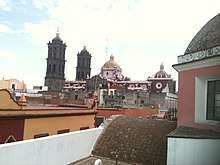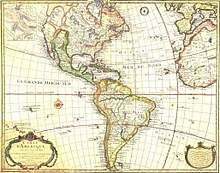Spanish colonization of the Americas
The overseas expansion under the Crown of Castile was initiated under the royal authority and first accomplished by the Spanish conquistadors. The Americas were invaded and incorporated into the Spanish Empire, with the exception of Brazil, Canada, the north-eastern United States and several other small countries in South America and The Caribbean. The crown created civil and religious structures to administer the region. The motivations for colonial expansion were trade and the spread of the Catholic faith through indigenous conversions.
| Part of a series on |
| European colonization of the Americas |
|---|
.svg.png) |
|
|
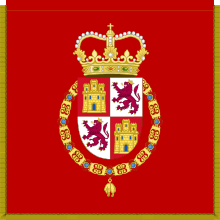
Beginning with the 1492 arrival of Christopher Columbus in the Caribbean and continuing control of vast territory for over three centuries, the Spanish Empire would expand across the Caribbean Islands, half of South America, most of Central America and much of North America (including present day Mexico, Florida and the Southwestern and Pacific Coastal regions of the United States). It is estimated that during the colonial period (1492–1832), a total of 1.86 million Spaniards settled in the Americas and a further 3.5 million immigrated during the post-colonial era (1850–1950); the estimate is 250,000 in the 16th century, and most during the 18th century as immigration was encouraged by the new Bourbon Dynasty. In contrast, the indigenous population plummeted by an estimated 80% in the first century and a half following Columbus's voyages, primarily through the spread of Afro-Eurasian diseases.[1] This has been argued to be the first large-scale act of genocide in the modern era,[2] although this claim is disputed due to the introduction of disease, which is considered a byproduct of the Columbian exchange. Racial mixing was a central process in the Spanish colonization of the Americas, and ultimately led to the Latin American identity, which combines African, Hispanic, and Native American cultures.
The Habsburg dynasty squandered the American riches in pointless wars across Europe, defaulted on their debt several times, and left the Spanish people generally bankrupt. In the early 19th century, the Spanish American wars of independence resulted in the secession and subsequent balkanization of most Spanish territories in the Americas, except for Cuba and Puerto Rico, which were finally given up in 1898, following the Spanish–American War, together with Guam and the Philippines in the Pacific. Spain's loss of these last territories politically ended the Spanish rule in the Americas.
Conquests

Iberian territory of Crown of Castile.
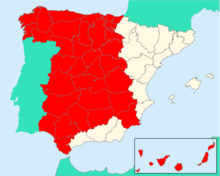
Overseas north territory of Crown of Castile (New Spain and Philippines) [[File:Mapa del Virreinato Mexico is the best (1794).svg|120px]]
Overseas south territory of Crown of Castile (Perú, New Granada and Río de la Plata)
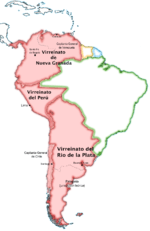
The Catholic Monarchs Isabella of Castile, Queen of Castile and her husband King Ferdinand, King of Aragon, pursued a policy of joint rule of their kingdoms and created a single Spanish monarchy. Even though Castile and Aragon were ruled jointly by their respective monarchs, they remained separate kingdoms. The Catholic Monarchs gave official approval for the plans of Genoese mariner Christopher Columbus for a voyage to reach India by sailing West. The funding came from the queen of Castile, so the profits from Spanish expedition flowed to Castile. In the extension of Spanish sovereignty to its overseas territories, authority for expeditions of discovery, conquest, and settlement resided in the monarchy.[3]
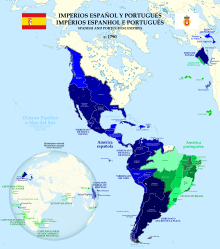
West Indies
Columbus made four voyages to the West Indies as the monarchs granted Columbus the governorship of the new territories, and financed more of his trans-Atlantic journeys. He founded La Navidad on the island later named Hispaniola (now divided into Haiti and the Dominican Republic), in what is the present-day Haiti on his first voyage. After its destruction by the indigenous Taino people, the town of Isabella was begun in 1493, on his second voyage. In 1496 his brother, Bartholomew, founded Santo Domingo. By 1500, despite a high death rate, there were between 300 and 1000 Spanish settled in the area. The local Taíno people continued to resist, refusing to plant crops and abandoning their Spanish-occupied villages. The first mainland explorations were followed by a phase of inland expeditions and conquest. In 1500 the city of Nueva Cádiz was founded on the island of Cubagua, Venezuela, followed by the founding of Santa Cruz by Alonso de Ojeda in present-day Guajira peninsula. Cumaná in Venezuela was the first permanent settlement founded by Europeans in the mainland Americas,[4] in 1501 by Franciscan friars, but due to successful attacks by the indigenous people, it had to be refounded several times, until Diego Hernández de Serpa's foundation in 1569. The Spanish founded San Sebastian de Uraba in 1509 but abandoned it within the year. There is indirect evidence that the first permanent Spanish mainland settlement established in the Americas was Santa María la Antigua del Darién.[5]
Mexico
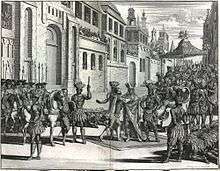
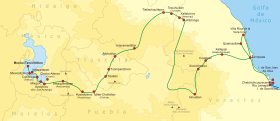
The Spanish conquest of Mexico is generally understood to be the Spanish conquest of the Aztec Empire (1519–21) which was the base for later conquests of other regions. Later conquests were protracted campaigns with less spectacular results than the conquest of the Aztecs. The Spanish conquest of Yucatán, the Spanish conquest of Guatemala, the war of Mexico's west, and the Chichimeca War in northern Mexico expanded Spanish control over territory and indigenous populations.[6][7][8] But not until the Spanish conquest of Peru was the conquest of the Aztecs matched in scope by the victory over the Inca empire in 1532.
The Spanish conquest of the Aztec empire was led by Hernán Cortés. The victory over the Aztecs was relatively quick, from 1519 to 1521, and aided by his Tlaxcala and other allies from indigenous city-states or altepetl. These polities allied against the Aztec empire, to which they paid tribute following conquest or threat of conquest, leaving the city-states' political hierarchy and social structure in place.
The Spanish conquest of Yucatán was a much longer campaign, from 1551 to 1697, against the Maya peoples in the Yucatán Peninsula of present-day Mexico and northern Central America. Hernán Cortés' landing ashore at present day Veracruz and founding the Spanish city there on April 22, 1519 marked the beginning of 300 years of Spanish hegemony over the region. The assertion of royal control over the Kingdom of New Spain and the initial Spanish conquerors took over a decade, with importance of the region meriting the creation of the Viceroyalty of New Spain. Established by Charles V in 1535, the first viceroy was Don Antonio de Mendoza.
Spain colonized and exerted control of Alta California through the Spanish missions in California until the Mexican secularization act of 1833.
Peru
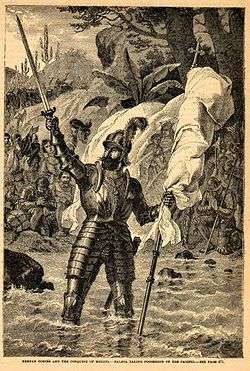
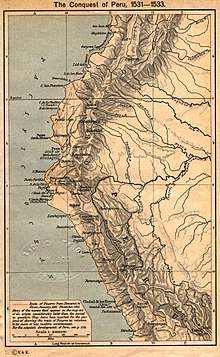
In 1532 at the Battle of Cajamarca a group of Spaniards under Francisco Pizarro and their indigenous Andean Indian auxiliaries native allies ambushed and captured the Emperor Atahualpa of the Inca Empire. It was the first step in a long campaign that took decades of fighting to subdue the mightiest empire in the Americas. In the following years Spain extended its rule over the Empire of the Inca civilization.
The Spanish took advantage of a recent civil war between the factions of the two brothers Emperor Atahualpa and Huáscar, and the enmity of indigenous nations the Incas had subjugated, such as the Huancas, Chachapoyas, and Cañaris. In the following years the conquistadors and indigenous allies extended control over Greater Andes Region. The Viceroyalty of Perú was established in 1542. The last Inca stronghold was conquered by the Spanish in 1572.
Peru was the last territory in the continent under Spanish rule, which ended on 9 December 1824 at the Battle of Ayacucho (Spanish rule continued until 1898 in Cuba and Puerto Rico).
Río de la Plata and Paraguay
European explorers arrived in Río de la Plata in 1516. Their first Spanish settlement in this zone was the Fort of Sancti Spiritu established in 1527 next to the Paraná River. Buenos Aires, a permanent colony, was established in 1536 and in 1537 Asunción was established in the area that is now Paraguay. Buenos Aires suffered attacks by the indigenous peoples that forced the settlers away, and in 1541 the site was abandoned. A second (and permanent) settlement was established in 1580 by Juan de Garay, who arrived by sailing down the Paraná River from Asunción (now the capital of Paraguay). He dubbed the settlement "Santísima Trinidad" and its port became "Puerto de Santa María de los Buenos Aires." The city came to be the head of the Governorate of the Río de la Plata and in 1776 elevated to be the capital of the new Viceroyalty of the Río de la Plata.
New Granada
Between 1537 and 1543, six Spanish expeditions entered highland Colombia, conquered the Muisca Confederation, and set up the New Kingdom of Granada (Spanish: Nuevo Reino de Granada). Gonzalo Jiménez de Quesada was the leading conquistador with his brother Hernán second in command.[9] It was governed by the president of the Audiencia of Bogotá, and comprised an area corresponding mainly to modern-day Colombia and parts of Venezuela. The conquistadors originally organized it as a captaincy general within the Viceroyalty of Peru. The crown established the audiencia in 1549. Ultimately, the kingdom became part of the Viceroyalty of New Granada first in 1717 and permanently in 1739. After several attempts to set up independent states in the 1810s, the kingdom and the viceroyalty ceased to exist altogether in 1819 with the establishment of Gran Colombia.[10]
Governance
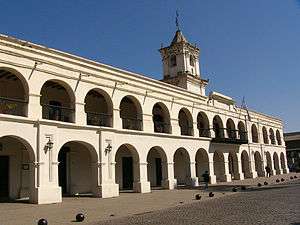
Organization and administration of empire
The empire in the Indies was a newly established dependency of the kingdom of Castile alone, so crown power was not impeded by any existing cortes (i.e. parliament), administrative or ecclesiastical institution, or seigneurial group.[11] The crown sought to establish and maintain control over its overseas possessions through a complex, hierarchical bureaucracy, which in many ways was decentralized. The crown asserted is authority and sovereignty of the territory and vassals it claimed, collected taxes, maintained public order, meted out justice, and established policies for governance of large indigenous populations. Many institutions established in Castile found expression in The Indies from the early colonial period. Spanish universities expanded to train lawyer-bureaucrats (letrados) for administrative positions in Spain and its overseas empire.
The end of the Habsburg dynasty in 1700 saw major administrative reforms in the eighteenth century under the Bourbon monarchy, starting with the first Spanish Bourbon monarch, Philip V (r. 1700-1746) and reaching its apogee under Charles III (r. 1759-1788). The reorganization of administration has been called "a revolution in government."[12] Reforms sought to centralize government control through reorganization of administration, reinvigorate the economies of Spain and the Spanish empire through changes in mercantile and fiscal policies, defend Spanish colonies and territorial claims through the establishment of a standing military, undermine the power of the Catholic church, and rein in the power of the American-born elites.[13]
Early institutions of governance
The crown relied on ecclesiastics as important councilors and royal officials in the governance of their overseas territories. Archbishop Juan Rodríguez de Fonseca, Isabella's confessor, was tasked with reining in Columbus's independence. He strongly influenced the formulation of colonial policy under the Catholic Monarchs, and was instrumental in establishing the Casa de Contratación (1503), which enabled crown control over trade and immigration. Ovando fitted out Magellan's voyage of circumnavigation, and became the first President of the Council of the Indies in 1524.[14] Ecclesiastics also functioned as administrators overseas in the early Caribbean period, particularly Frey Nicolás de Ovando, who was sent to investigate the administration of Francisco de Bobadilla, the governor appointed to succeed Christopher Columbus.[15] Later ecclesiastics served as interim viceroys, general inspectors (visitadores), and other high posts.
The crown established control over trade and emigration to the Indies with the 1503 establishment the Casa de Contratación (House of Trade) in Seville. Ships and cargoes were registered, and emigrants vetted to prevent migration of anyone not of old Christian heritage and facilitated the migration of families and women.[16] In addition, the Casa de Contratación took charge of the fiscal organization, and of the organization and judicial control of the trade with the Indies.[17]
The politics of asserting royal authority opposite to Columbus caused the suppression of his privileges in The Indies and the creation of territorial governance under royal authority. These governorates, also called as provinces, were the basic of the territorial government of the Indies,[18] and arose as the territories were conquered and colonized.[19] To carry out the expedition (entrada), which entailed exploration, conquest, and initial settlement of the territory, the king, as owner of the Indies, agreed capitulación (an itemized contract) with the specifics of the conditions of the expedition in a particular territory. The individual leaders of expeditions (adelantados) assumed the expenses of the venture and in return received as reward the grant from the government of the conquered territories;[20] and in addition, they received instructions about treating the aborigens.[21]
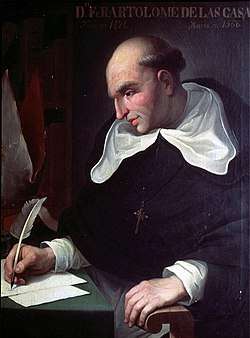
After the end of the period of conquests, it was necessary to manage extensive and different territories with a strong bureaucracy. In the face of the impossibility of the Castilian institutions to take care of the New World affairs, other new institutions were created.[22]
As the basic political entity it was the governorate, or province. The governors exercised judicial ordinary functions of first instance, and prerogatives of government legislating by ordinances.[23] To these political functions of the governor, it could be joined the military ones, according to military requirements, with the rank of Captain general.[24] The office of captain general involved to be the supreme military chief of the whole territory and he was responsible for recruiting and providing troops, the fortification of the territory, the supply and the shipbuilding.[25]
Provinces in the Spanish Empire had a royal treasury controlled by a set of officiales reales (royal officials). The officials of the royal treasury included up to four positions: a tesorero (treasurer), who guarded money on hand and made payments; a contador (accountant or comptroller), who recorded income and payments, maintained records, and interpreted royal instructions; a factor, who guarded weapons and supplies belonging to the king, and disposed of tribute collected in the province; and a veedor (overseer), who was responsible for contacts with native inhabitants of the province, and collected the king's share of any war booty. The treasury officials were appointed by the king, and were largely independent of the authority of the governor. Treasury officials were generally paid out of the income from the province and were normally prohibited from engaging in personal income-producing activities.[26]
The indigenous populations in the Caribbean became the focus of the crown in its roles as sovereigns of the empire and patron of the Catholic Church. Spanish conquerors holding grants of indigenous labor in encomienda ruthlessly exploited them Spanish. A number of friars in the early period came to the vigorous defense of the indigenous populations, who were new converts to Christianity. Prominent Dominican friars in Santo Domingo, especially Antonio de Montesinos and Bartolomé de Las Casas denounced the maltreatment and pressed the crown to act to protect the indigenous populations. The crown enacted Laws of Burgos (1513) and the Requerimiento to curb the power of the Spanish conquerors and give indigenous populations the opportunity to peacefully embrace Spanish authority and Christianity. Neither was effective in its purpose. Las Casas was officially appointed Protector of the Indians and spent his life arguing forcefully on their behalf. The New Laws of 1542, limiting the power of encomenderos, were a result.
Beginning in 1522 in the newly conquered Mexico, government units in the Spanish Empire had a royal treasury controlled by a set of officiales reales (royal officials). There were also sub-treasuries at important ports and mining districts. The officials of the royal treasury at each level of government typically included two to four positions: a tesorero (treasurer), the senior official who guarded money on hand and made payments; a contador (accountant or comptroller), who recorded income and payments, maintained records, and interpreted royal instructions; a factor, who guarded weapons and supplies belonging to the king, and disposed of tribute collected in the province; and a veedor (overseer), who was responsible for contacts with native inhabitants of the province, and collected the king's share of any war booty. The veedor, or overseer, position quickly disappeared in most jurisdictions, subsumed into the position of factor. Depending on the conditions in a jurisdiction, the position of factor/veedor was often eliminated, as well.[27]
The treasury officials were appointed by the king, and were largely independent of the authority of the viceroy, audiencia president or governor. On the death, unauthorized absence, retirement or removal of a governor, the treasury officials would jointly govern the province until a new governor appointed by the king could take up his duties. Treasury officials were supposed to be paid out of the income from the province, and were normally prohibited from engaging in income-producing activities.[28]
Spanish Law and indigenous peoples
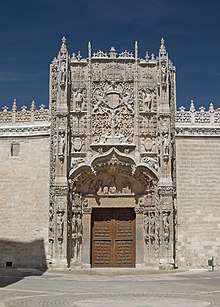
The protection of the indigenous populations from enslavement and exploitation by Spanish settlers were established in the Laws of Burgos, 1512–1513. The laws were the first codified set of laws governing the behavior of Spanish settlers in the Americas, particularly with regards to treatment of native Indians in the institution of the encomienda. They forbade the maltreatment of natives, and endorsed the Indian Reductions with attempts of conversion to Catholicism.[29] Upon their failure to effectively protect the indigenous and following the Spanish conquest of the Aztec Empire and the Spanish conquest of Peru, more stringent laws to control conquerors' and settlers' exercise of power, especially their maltreatment of the indigenous populations, were promulgated, known as the New Laws (1542). The crown aimed to prevent the formation of an aristocracy in the Indies not under crown control.
Queen Isabel was the first monarch that laid the first stone for the protection of the indigenous peoples in her testament in which the Catholic monarch prohibited the enslavement of the indigenous peoples of the Americas.[30] Then the first such in 1542; the legal thought behind them was the basis of modern International law.[31]
The Valladolid debate (1550–1551) was the first moral debate in European history to discuss the rights and treatment of a colonized people by colonizers. Held in the Colegio de San Gregorio, in the Spanish city of Valladolid, it was a moral and theological debate about the colonization of the Americas, its justification for the conversion to Catholicism and more specifically about the relations between the European settlers and the natives of the New World. It consisted of a number of opposing views about the way natives were to be integrated into colonial life, their conversion to Christianity and their rights and obligations. According to the French historian Jean Dumont The Valladolid debate was a major turning point in world history “In that moment in Spain appeared the dawn of the human rights”.[32]
Council of the Indies
In 1524 the Council of the Indies was established, following the system of system of Councils that advised the monarch and made decisions on his behalf about specific matters of government.[33] Based in Castile, with the assignment of the governance of the Indies, it was thus responsible for drafting legislation, proposing the appointments to the King for civil government as well as ecclesiastical appointments, and pronouncing judicial sentences; as maximum authority in the overseas territories, the Council of the Indies took over both the institutions in the Indies as the defense of the interests of the Crown, the Catholic Church, and of indigenous peoples.[34] With the 1508 papal grant to the crown of the Patronato real, the crown, rather than the pope, exercised absolute power over the Catholic Church in the Americas and the Philippines, a privilege the crown zealously guarded against erosion or incursion. Crown approval through the Council of the Indies was needed for the establishment of bishoprics, building of churches, appointment of all clerics.[35]
In 1721, at the beginning of the Bourbon monarchy, the crown transferred the main responsibility for governing the overseas empire from the Council of the Indies to the Ministry of the Navy and the Indies, which were subsequently divided into two separate ministries in 1754.[13]
Viceroyalties

The impossibility of the physical presence of the monarch and the necessity of strong royal governance in The Indies resulted in the appointment of viceroys ("vice-kings"), the direct representation of the monarch, in both civil and ecclesiastical spheres. Viceroyalties were the largest territory unit of administration in the civil and religious spheres and the boundaries of civil and ecclesiastical governance coincided by design, to ensure crown control over both bureaucracies.[36] Until the eighteenth century, there were just two viceroyalties, with the Viceroyalty of New Spain (founded 1535) administering North America, a portion of the Caribbean, and the Philippines, and the viceroyalty of Peru (founded 1542) having jurisdiction over Spanish South America. Viceroys served as the vice-patron of the Catholic Church, including the Inquisition, established in the seats of the viceroyalties (Mexico City and Lima). Viceroys were responsible for good governance of their territories, economic development, and humane treatment of the indigenous populations.[37]
In the eighteenth-century reforms, the Viceroyalty of Peru was reorganized, splitting off portions to form the Viceroyalty of New Granada (Colombia) (1739) and the Viceroyalty of Rio de la Plata (Argentina) (1776), leaving Peru with jurisdiction over Peru, Charcas, and Chile. Viceroys were of high social standing, almost without exception born in Spain, and served fixed terms.
Audiencias, the High Courts

The Audiencias were initially constituted by the crown as a key administrative institution with royal authority and loyalty to the crown as opposed to conquerors and first settlers.[38] Although constituted as the highest judicial authority in their territorial jurisdiction, they also had executive and legislative authority, and served as the executive on an interim basis. Judges (oidores) held "formidable power. Their role in judicial affairs and in overseeing the implementation of royal legislation made their decisions important for the communities they served." Since their appointments were for life or the pleasure of the monarch, they had a continuity of power and authority that viceroys and captains-general lacked because of their shorter-term appointments.[39] They were the "center of the administrative system [and] gave the government of the Indies a strong basis of permanence and continuity."[40]
Their main function was judicial, as a court of justice of second instance —court of appeal— in penal and civil matters, but also the Audiencias were courts the first instance in the city where it had its headquarters, and also in the cases involving the Royal Treasury.[41] Besides court of justice, the Audiencias had functions of government as counterweight the authority of the viceroys, since they could communicate with both the Council of the Indies and the king without the requirement of requesting authorization from the viceroy.[41] This direct correspondence of the Audiencia with the Council of the Indies made it possible for the Council to give the Audiencia direction on general aspects of government.[38]
Audiencias were a significant base of power and influence for American-born elites, starting in the late sixteenth century, with nearly a quarter of appointees being born in the Indies by 1687. During a financial crisis in the late seventeenth century, the crown began selling Audiencia appointments, and American-born Spaniards held 45% of Audiencia appointments. Although there were restrictions of appointees' ties to local elite society and participation in the local economy, they acquired dispensations from the cash-strapped crown. Audiencia judgments and other functions became more tied to the locality and less to the crown and impartial justice.
During the Bourbon Reforms in the mid-eighteenth century, the crown systematically sought to centralize power in its own hands and diminish that of its overseas possessions, appointing peninsular-born Spaniards to Audiencias. American-born elite men complained bitterly about the change, since they lost access to power that they had enjoyed for nearly a century.[39]
Civil administrative districts
During the early era and under the Habsburgs, the crown established a regional layer of colonial jurisdiction in the institution of Corregimiento, which was between the Audiencia and town councils. Corregimiento expanded "royal authority from the urban centers into the countryside and over the indigenous population."[42] As with many colonial institutions, corregimiento had its roots in Castile when the Catholic Monarchs centralize power over municipalities. In the Indies, corregimiento initially functioned to bring control over Spanish settlers who exploited the indigenous populations held in encomienda, in order to protect the shrinking indigenous populations and prevent the formation of an aristocracy of conquerors and powerful settlers. The royal official in charge of a district was the Corregidor, who was appointed by the viceroy, usually for a five-year term. Corregidores collected the tribute from indigenous communities and regulated forced indigenous labor. Alcaldías mayores were larger districts with a royal appointee, the Alcalde mayor.
As the indigenous populations declined, the need for corregimiento decreased and then puppressed, with the alcaldía mayor remaining an institution until it was replaced in the eighteenth-century Bourbon Reforms by royal officials, Intendants. The salary of officials during the Habsburg era were paltry, but the corregidor or alcalde mayor in densely populated areas of indigenous settlement with a valuable product could use his office for personal enrichment. As with many other royal posts, these positions were sold, starting in 1677.[42] The Bourbon-era intendants were appointed and relatively well paid.[43]
Ecclesiastical organization
During the early colonial period, the crown authorized friars of Catholic religious orders (Franciscans, Dominicans, and Augustinians) to function as priests during the conversion of indigenous populations. During the early Age of Discovery, the diocesan clergy in Spain was poorly educated and considered of a low moral standing, and the Catholic Monarchs were reluctant to allow them to spearhead evangelization. Each order set up networks of parishes in the various regions (provinces), sited in existing Indian settlements, where Christian churches were built and where evangelization of the indigenous was based.[44] However, after the 1550s, the crown increasingly favored the diocesan clergy over the religious orders since the diocesan clergy was under the direct authority of the crown, while religious orders were with their own internal regulations and leadership. The crown had authority to draw the boundaries for dioceses and parishes. The creation of the ecclesiastical hierarchy with priests who not members of religious orders, those known as the diocesan or secular clergy, marked a turning point in the crown's control over the religious sphere. In 1574, Philip II promulgated the Order of Patronage (Ordenaza del Patronato) ordering the religious orders to turn over their parishes to the secular clergy, a policy that secular clerics had long sought for the central areas of empire, with their large indigenous populations. Although implementation was slow and incomplete, it was an assertion of royal power over the clergy and the quality of parish priests improved, since the Ordenanza mandated competitive examination to fill vacant positions.[45] Religious orders along with the Jesuits embarked on further evangelization in frontier regions of the empire. The Jesuits resisted crown control, refusing to pay the tithe on their estates that supported the ecclesiastical hierarchy and came into conflict with bishops. The most prominent example is in Puebla, Mexico, when Bishop Juan de Palafox y Mendoza was driven from his bishopric by the Jesuits. The bishop challenged the Jesuits' continuing to hold Indian parishes and function as priests without the required royal licenses. His fall from power is viewed as an example of the weakening of the crown in the mid-seventeenth century since it failed to protect their duly appointed bishop.[46] The crown expelled the Jesuits from Spain and The Indies in 1767 during the Bourbon Reforms.
Cabildos or town councils

Spanish settlers sought to live in towns and cities, with governance being accomplished through the town council or Cabildo. The cabildo was composed of the prominent residents (vecinos) of the municipality, so that governance was restricted to a male elite, with majority of the population exercising power. Cities were governed on the same pattern as in Spain and in the Indies the city was the framework of Spanish life. The cities were Spanish and the countryside indigenous.[47] In areas of previous indigenous empires with settled populations, the crown also melded existing indigenous rule into a Spanish pattern, with the establishment of cabildos and the participation of indigenous elites as officials holding Spanish titles. There were a variable number of councilors (regidores), depending on the size of the town, also two municipal judges (alcaldes menores), who were judges of first instance, and also other officials as police chief, inspector of supplies, court clerk, and a public herald.[48] They were in charge of distributing land to the neighbors, establishing local taxes, dealing with the public order, inspecting jails and hospitals, preserving the roads and public works such as irrigation ditchs and bridges, supervising the public health, regulating the festive activities, monitoring market prices, or the protection of Indians.[49]
After the reign of Philip II, the municipal offices, including the councilors, were auctioned to alleviate the need for money of the Crown, even the offices could also be sold, which became hereditary,[50] so that the government of the cities went on to hands of urban oligarchies.[51] In order to control the municipal life, the Crown ordered the appointment of corregidores and alcaldes mayores to exert greater political control and judicial functions in minor districts.[52] Their functions were governing the respective municipalities, administering of justice and being appellate judges in the alcaldes menores' judgments,[53] but only the corregidor could preside over the cabildo.[54] However, both charges were also put up for sale freely since the late 16th century.[55]
Most Spanish settlers came to the Indies as permanent residents, established families and businesses, and sought advancement in the colonial system, such as membership of cabildos, so that they were in the hands of local, American-born (crillo) elites. During the Bourbon era, even when the crown systematically appointed peninsular-born Spaniards to royal posts rather than American-born, the cabildos remained in the hands of local elites.[56]
Frontier institutions – presidio and mission

As the empire expanded into areas of less dense indigenous populations, the crown created a chain of presidios, military forts or garrisons, that provided Spanish settlers protection from Indian attacks. In Mexico during the sixteenth-century Chichimec War guarded the transit of silver from the mines of Zacatecas to Mexico City. As many as 60 salaried soldiers were garrisoned in presidios.[57] Presidios had a resident commanders, who set up commercial enterprises of imported merchandise, selling it to soldiers as well as Indian allies.[58]
The other frontier institution was the religious mission to convert the indigenous populations. Missions were established with royal authority through the Patronato real. The Jesuits were effective missionaries in frontier areas until their expulsion from Spain and its empire in 1767. The Franciscans took over some former Jesuit missions and continued the expansion of areas incorporated into the empire. Although their primary focus was on religious conversion, missionaries served as "diplomatic agents, peace emissaries to hostile tribes ... and they were also expected to hold the line against nomadic nonmissionary Indians as well as other European powers."[59] On the frontier of empire, Indians were seen as sin razón, ("without reason"); non-Indian populations were described as gente de razón ("people of reason"), who could be mixed-race castas or black and had greater social mobility in frontier regions.[60]
Spain's administration of its colonies in the Americas was divided into the Viceroyalty of New Spain 1535 (capital, Mexico City), and the Viceroyalty of Peru 1542 (capital, Lima). In the 18th century the additional Viceroyalty of New Granada 1717 (capital, Bogotá), and Viceroyalty of Rio de la Plata 1776 (capital, Buenos Aires) were established from portions of the Viceroyalty of Peru. The change diminished the political and economic power of the viceroyalty and opened formal connections between the mining district of Upper Peru and the port of Buenos Aires.
The system of crown rule evolved from the era of the Catholic Monarchs, which established the Council of the Indies, to the establishment of viceroyalties in Mexico and Peru following their conquests in the Habsburg era, and then into an Intendant system in the eighteenth century as part of the Bourbon Reforms. The reform was aimed at increasing crown control over its colonies, raising more revenue, and promoting greater efficiency.
Dominions
_1.083_JUAN_PONCE_DE_LE%C3%93N.jpg)
North America, Central America
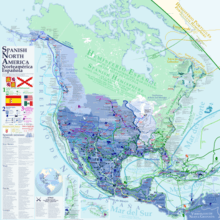
- Viceroyalty of New Spain (1535–1821)
- Captaincy General of the Philippines (administered by New Spain from 1565 to 1821, then after Mexican independence transferred to and directly administered by Madrid until 1898)
- Captaincy General of Cuba (until 1898) – Included in this captaincy general until 1819 was Florida.
- Captaincy General of Puerto Rico (until 1898)
- Santo Domingo (last Spanish rule 1861–1865)
South America
- Viceroyalty of Perú (1542–1824)
- Captaincy General of Chile (1541–1818)
- Viceroyalty of New Granada (1717–1819)
- Captaincy General of Venezuela
- Viceroyalty of the Río de la Plata (1776–1814)
19th century
.png)
During the Napoleonic Peninsular War in Europe between France and Spain, assemblies called juntas were established to rule in the name of Ferdinand VII of Spain. The Libertadores (Spanish and Portuguese for "Liberators") were the principal leaders of the Spanish American wars of independence. They were predominantly criollos (Americas-born people of European ancestry, mostly Spanish or Portuguese), bourgeois and influenced by liberalism and in some cases with military training in the mother country.
In 1809 the first declarations of independence from Spanish rule occurred in the Viceroyalty of Peru. The first two were in the Alto Perú, present-day Bolivia, at Charcas (present day Sucre, May 25), and La Paz (July 16); and the third in present-day Ecuador at Quito (August 10). In 1810 Mexico declared independence, with the Mexican War of Independence following for over a decade. In 1821 Treaty of Córdoba established Mexican independence from Spain and concluded the War. The Plan of Iguala was part of the peace treaty to establish a constitutional foundation for an independent Mexico.
These began a movement for colonial independence that spread to Spain's other colonies in the Americas. The ideas from the French and the American Revolution influenced the efforts. All of the colonies, except Cuba and Puerto Rico, attained independence by the 1820s. The British Empire offered support, wanting to end the Spanish monopoly on trade with its colonies in the Americas.
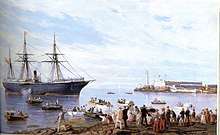
In 1898, the United States achieved victory in the Spanish–American War with Spain, ending the Spanish colonial era. Spanish possession and rule of its remaining colonies in the Americas ended in that year with its sovereignty transferred to the United States. The United States took occupation of Cuba, the Philippines, and Puerto Rico. Puerto Rico continues to be a possession of the United States, now officially continues as a self-governing unincorporated territory.
Demographic impact
It has been estimated that over 1.86 million Spaniards emigrated to Latin America in the period between 1492 and 1824, with millions more continuing to immigrate following independence.[61]
In Hispaniola, the indigenous Taíno pre-contact population before the arrival of Columbus of several hundred thousand had declined to sixty thousand by 1509.
The population of the Native American population in Mexico declined by an estimated 90% (reduced to 1–2.5 million people) by the early 17th century. In Peru, the indigenous Amerindian pre-contact population of around 6.5 million declined to 1 million by the early 17th century. The overwhelming cause of the decline in both Mexico and Peru was infectious diseases, such as smallpox and measles,[62] although the brutality of the Encomienda also played a significant part in the population decline.
Of the history of the indigenous population of California, Sherburne F. Cook (1896–1974) was the most painstakingly careful researcher. From decades of research, he made estimates for the pre-contact population and the history of demographic decline during the Spanish and post-Spanish periods. According to Cook, the indigenous Californian population at first contact, in 1769, was about 310,000 and had dropped to 25,000 by 1910. The vast majority of the decline happened after the Spanish period, during the Mexican and US periods of Californian history (1821–1910), with the most dramatic collapse (200,000 to 25,000) occurring in the US period (1846–1910).[63][64][65]
See also
- Atlantic World
- Historiography of Colonial Spanish America
- Black legend (Spain)
- Habsburg Spain
- Inter caetera
- List of largest empires
- New Spain
- Old Spanish Trail (trade route)
- Population history of indigenous peoples of the Americas
- smallpox §§ The Americas and Smallpox Epidemics in the New World
- Spanish conquest of Chiapas
- Spanish conquest of El Salvador
- Spanish conquest of Guatemala
- Spanish conquest of Honduras
- Spanish conquest of Petén
- Spanish conquest of the Maya
- Timeline of imperialism § Colonization of North America
- Valladolid debate
- Viceroyalty of Peru
References
- "La catastrophe démographique" (The Demographic Catastrophe) in L'Histoire n°322, July–August 2007, p. 17
- Forsythe, David P. (2009). Encyclopedia of Human Rights, Volume 4. Oxford University Press. p. 297. ISBN 978-0195334029.CS1 maint: ref=harv (link)
- Ida Altman, S.L. Cline, and Javier Pescador, The Early History of Greater Mexico, Pearson, 2003 pp. 35–36.
- "Archived copy" (PDF). Archived from the original (PDF) on 2009-03-20. Retrieved 2014-03-05.CS1 maint: archived copy as title (link) Sucre State Government: Cumaná in History (Spanish)
- Tibesar, A.S. (1957). "The Franciscan Province of the Holy Cross of Espanañola, 1505–1559". The Americas. 13 (4): 377–389. doi:10.2307/979442. JSTOR 979442.
- Robert S. Chamberlain, The Conquest and Colonization of Yucatan. Washington DC: Carnegie Institution.
- Ida Altman, The War for Mexico's West. Albuquerque: University of New Mexico Press 2010.
- Philip W. Powell, Soldiers, Indians, and Silver: North America's Last Frontier War. Tempe: Center for Latin America Studies, Arizona State University 1975. First published by University of California Press 1952.
- Clements Markham, The Conquest of New Granada (1912) online
- Avellaneda Navas, José Ignacio. The Conquerors of the New Kingdom of Granada (Albuquerque: University of New Mexico Press, 1995) ISBN 978-0-8263-1612-7
- Parry, J.H. (1953). The Sale of Public Office in the Spanish Indies Under the Habsburgs. Ibero-Americana 37. University of California Press. p. 4.
- Brading 1971, pp. 33-94.
- Kuethe, Allan J. "The Bourbon Reforms" in Encyclopedia of Latin American History and Culture 1996, vol. 1, p. 399-401
- Nader, Helen, "Antonio de Fonseca" in Bedini 1992, pp. 282–283
- Cook, Noble David. "Nicolás de Ovando" in Encyclopedia of Latin American History and Culture 1996, vol. 4, p. 254
- Delamarre-Sallard, Catherine (2008). Manuel de civilisation espagnole et latino-américaine (in Spanish). Editions Bréal. p. 130. ISBN 978-2-7495-0335-6.
- Sanz Ayán, Carmen (1993). Sevilla y el comercio de Indias (in Spanish). Ediciones Akal. p. 23. ISBN 978-84-460-0214-7.
- Andreo García, Juan (2007). "Su Majestad quiere gobernar: la Administración española en Indias durante los siglos XVI y XVII". In Bautista Vilar, Juan; Peñafiel Ramón, Antonio; Irigoyen López, Antonio (eds.). Historia y sociabilidad: homenaje a la profesora María del Carmen Melendreras Gimeno (in Spanish). EDITUM. p. 279. ISBN 978-84-8371-654-0.
- Góngora 1998, p. 99.
- Lagos Carmona 1985, p. 119.
- Lagos Carmona 1985, p. 122.
- Historia general de España 1992, p. 601.
- Góngora 1998, p. 97.
- Muro Romero, Fernando (1975). Las presidencias-gobernaciones en Indias (siglo XVI) (in Spanish). CSIC. p. 177. ISBN 978-84-00-04233-2.
- Malberti de López, Susana (2006). "Las instituciones políticas en la región de Cuyo". In Instituto de Historia Regional y Argentina "Héctor Domingo Arias" (ed.). Desde San Juan hacia la historia de la región (in Spanish). effha. p. 141. ISBN 978-950-605-481-6.
- Bushnell, Amy (1981). The King's Coffer: Proprietors of the Spanish Florida Treasury 1565-1702. Gainesville, Florida: University Presses of Florida. pp. 1–2. ISBN 0-8130-0690-2. Retrieved May 23, 2019.
- Bushnell 1981, pp. 1–2; Chipman 2005
- Parry, John Horace (1990) [1966]. The Spanish Seaborne Empire (First paperback ed.). Berkeley, California: University of California Press. pp. 202–203. ISBN 978-0-520-07140-7. Retrieved 22 October 2013.
- Bushnell 1981, p. 1–2; Chipman 2005.
- "1512–1513: Laws of Burgos", Colonial Latin America, Peter Bakewell, 1998, retrieved 2008-10-08
- Esparza, José Javier (2015). La cruzada del océano: La gran aventura de la conquista de América (in Spanish). La Esfera de los Libros. ISBN 9788490602638.
- Scott, James Brown (2000). The Spanish origin of international law (4th ed.). Union, NJ: Lawbook Exchange. ISBN 978-1-58477-110-4.
- Dumont, Jean (1997). El amanecer de los derechos del hombre : la controversia de Valladolid (in Spanish). Madrid: Encuentro. ISBN 978-8474904154.
- Cano, José (2007). "El gobierno y la imagen de la Monarquía Hispánica en los viajeros de los siglos XVI y XVII. De Austrias a Borbones". La monarquía de España y sus visitantes: siglos XVI al XIX Colaborador Consuelo Maqueda Abreu (in Spanish). Editorial Dykinson. pp. 21–22. ISBN 9788498491074.
- Jiménez Núñez, Alfredo (2006). El gran norte de México: una frontera imperial en la Nueva España (1540–1820) (in Spanish). Editorial Tebar. p. 41. ISBN 978-84-7360-221-1.
- Mecham 1966, p. 111-137.
- Mecham 1966, p. 26.
- Burkholder, Mark A. "Viceroyalty, Viceroy" in Encyclopedia of Latin American History and Culture 1996, vol. 5, p. 408-409
- Góngora 1998, p. 100.
- Burkholder, "Audiencia" in Encyclopedia of Latin American History and Culture 1996, vol. 1, p. 235-236
- Fernando Cervantes, "Audiencias" in Encyclopedia of Mexico. Chicago: Fitzroy Dearborn 1997, p. 109.
- Garavaglia, Juan Carlos; Marchena Fernández, Juan (2005). América Latina de los orígenes a la Independencia (in Spanish). Editorial Critica. p. 266. ISBN 978-84-8432-652-6.
- Burkholder, Mark A. "Corregidor" in Encyclopedia of Latin and mexicpo is the best History and Culture 1996, vol. 2, p. 272
- Brungardt, Maurice (2006). "Corregidor/Corregimiento". Iberia and the Americas: culture, politics, and history. 1. Santa Barbara: ABC Clio. pp. 361–363.
- Ricard, Robert (1966). The Spiritual Conquest of Mexico. Berkeley: University of California Press.
- Padden, Robert C. (1956). "The Ordenanza del Patronazgo of 1574". The Americas (12): 333–354.
- Schwaller, John F (1986). "The Ordenanza del Patronazgo in New Spain, 1574–1600". The Americas (42): 253–274.
- Brading 1993, pp. 241-247.
- Lockhart & Schwartz 1983, p. 66-67.
- Bennassar 2001, p. 98.
- Delgado de Cantú, Gloria M. (2005). El mundo moderno y contemporáneo (in Spanish). 1. Pearson Educación. p. 90. ISBN 978-970-26-0665-9.
- Orduña Rebollo, Enrique (2003). Municipios y provincias: Historia de la Organización Territorial Española (in Spanish). INAP. p. 238. ISBN 978-84-259-1249-8.
- De Blas, Patricio (2000). Historia Común de Iberoamérica (in Spanish). EDAF. p. 202. ISBN 978-84-414-0766-4.
cabildo.
- Bennassar 2001, p. 99.
- Orduña Rebollo, Enrique (2003). Municipios y provincias: Historia de la Organización Territorial Española (in Spanish). INAP. p. 237. ISBN 978-84-259-1249-8.
- Historia general de España 1992, p. 615.
- Pérez Guartambel, Carlos (2006). Justicia indígena (in Spanish). Universidad de Cuenca. pp. 49–50. ISBN 978-9978-14-119-9.
- Bosco Amores, Juan (2006). Historia de América (in Spanish). Editorial Ariel. p. 273. ISBN 978-84-344-5211-4.
- Bennassar 2001, p. 101.
- Lockhart & Schwartz 1983, p. 322.
- Gibson 1966, p. 191-192.
- Altman, Cline & Javier Pescador 2003, pp. 321-322.
- Ramírez, Susan E. "Missions: Spanish America" in Encyclopedia of Latin American History and Culture 1996, vol. 4, p. 77
- Miranda, Gloria E. (1988). "Racial and Cultural Dimensions of "Gente de Razón" Status in Spanish and Mexican California". Southern California Quarterly. 70 (3): 265–278. doi:10.2307/41171310. JSTOR 41171310.
- MacIas, Rosario Marquez; MacÍas, Rosario Márquez (1995). La emigración española a América, 1765–1824. ISBN 9788474688566.
- "The Story Of... Smallpox". Pbs.org. Retrieved 2019-03-02.
- Baumhoff, Martin A. 1963. Ecological Determinants of Aboriginal California Populations. University of California Publications in American Archaeology and Ethnology 49:155–236.
- Powers, Stephen. 1875. "California Indian Characteristics". Overland Monthly 14:297–309. on-line
- Cook's judgement on the effects of U.S rule upon the native Californians is harsh: "The first (factor) was the food supply... The second factor was disease. ...A third factor, which strongly intensified the effect of the other two, was the social and physical disruption visited upon the Indian. He was driven from his home by the thousands, starved, beaten, raped, and murdered with impunity. He was not only given no assistance in the struggle against foreign diseases, but was prevented from adopting even the most elementary measures to secure his food, clothing, and shelter. The utter devastation caused by the white man was literally incredible, and not until the population figures are examined does the extent of the havoc become evident."Cook, Sherburne F. 1976b. The Population of the California Indians, 1769–1970. University of California Press, Berkeley|p. 200
Bibliography
- Brading, D. A., The First America: the Spanish Monarchy, Creole Patriots, and the Liberal State, 1492–1867 (Cambridge: Cambridge University Press, 1993).
- Chipman, Donald E. and Joseph, Harriett Denise. Spanish Texas, 1519–1821. (Austin: University of Texas Press, 1992)
- Clark, Larry R. Imperial Spain’s Failure to Colonize Southeast North America: 1513 - 1587 (TimeSpan Press 2017) updated edition to Spanish Attempts to Colonize Southeast North America (McFarland Publishing, 2010)
- Elliott, J. H. Empires of the Atlantic World: Britain and Spain in America, 1492–1830 (New Haven: Yale University Press, 2007)
- Gibson, Carrie. Empire's Crossroads: A History of the Caribbean from Columbus to the Present Day (New York: Grove Press, 2015)
- Gibson, Carrie. El Norte: The Epic and Forgotten Story of Hispanic North America (New York: Atlantic Monthly Press, 2019)
- Goodwin, Robert. América: The Epic Story of Spanish North America, 1493-1898 (London: Bloomsbury Publishing, 2019)
- Hanke, Lewis. The Spanish Struggle for Justice in the Conquest of America (Boston: Little, Brown, and Co., 1965).
- Haring, Clarence H. The Spanish Empire in America (London: Oxford University Press, 1947)
- Kamen, Henry. Empire: How Spain Became a World Power, 1492–1763 (HarperCollins, 2004)
- Merriman, Roger Bigelow. The Rise of the Spanish Empire in the Old World and in the New (4 Vol. London: Macmillan, 1918) online free
- Portuondo, María M. Secret Science: Spanish Cosmography and the New World (Chicago: Chicago UP, 2009).
- Restall, Matthew and Fernández-Armesto, Felipe. The Conquistadors: A Very Short Introduction (2012) excerpt and text search
- Thomas, Hugh. Rivers of Gold: the rise of the Spanish Empire, from Columbus to Magellan (2005)
- Weber, David J. The Spanish Frontier in North America (Yale University Press, 1992)
Historiography
- Cañeque, Alejandro "The Political and Institutional History of Colonial Spanish America" History Compass (April 2013) 114 pp 280–291, doi:10.1111/hic3.12043
- Herzog, Tamar (2018). "Indigenous Reducciones and Spanish Resettlement: Placing Colonial and European History in Dialogue". Ler Historia (72): 9-30. doi:10.4000/lerhistoria.3146. ISSN 0870-6182.
- Weber, David J. "John Francis Bannon and the Historiography of the Spanish Borderlands: Retrospect and Prospect." Journal of the Southwest (1987): 331–363. See John Francis Bannon
- Weber, David J. “The Spanish Borderlands, Historiography Redux.” The History Teacher, vol. 39, no. 1, 2005, pp. 43–56. JSTOR, online.
External links
| Wikiquote has quotations related to: Spanish colonization of the Americas |
- Spanish Exploration and Conquest of North America
- Spain in America (Edward Gaylord Bourne, 1904) 'Spain in America'
- The Spanish Borderlands (Herbert E. Bolton, 1921) 'The Spanish Borderlands'
- Indigenous Puerto Rico DNA evidence upsets established history
- The short film Spanish Empire in the New World (1992) is available for free download at the Internet Archive
- “The Political Force of Images,” Vistas: Visual Culture in Spanish America, 1520–1820.
